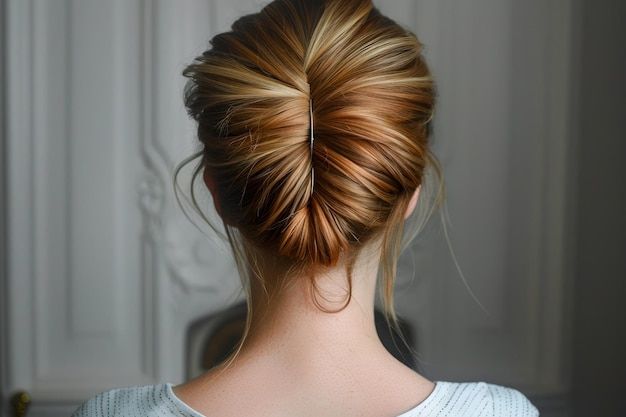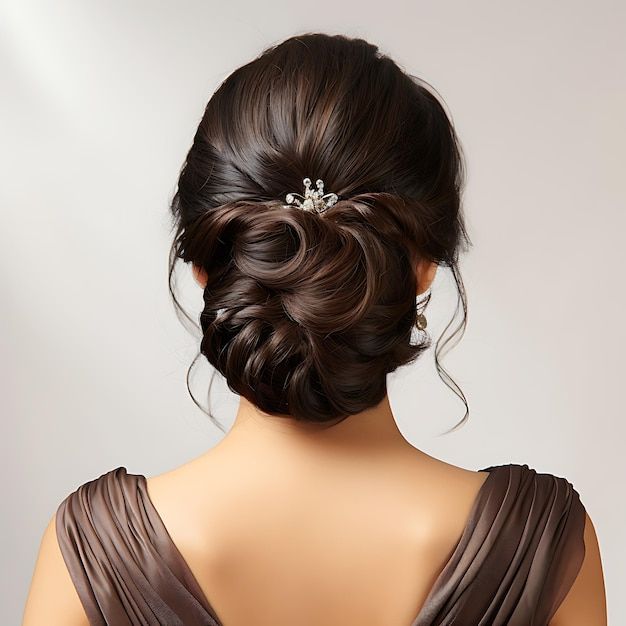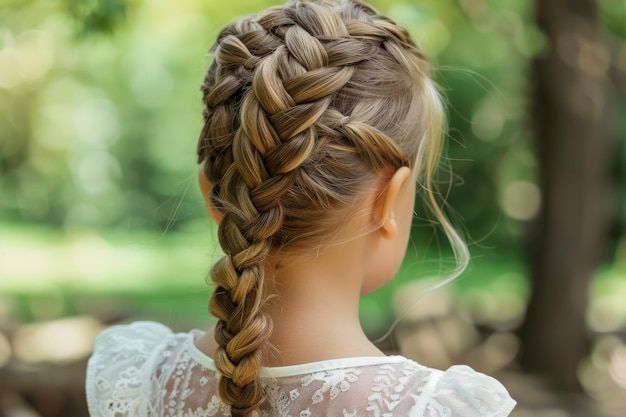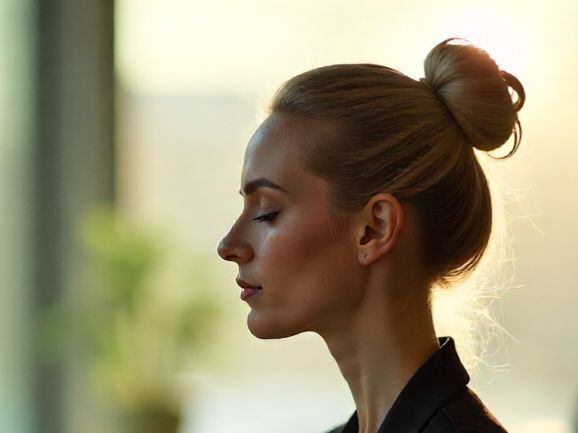The French Chignon Hairstyle: A Timeless Symbol of Elegance
The French chignon hairstyle is one of the most iconic and elegant updos in the history of hairstyling. Rooted in centuries of tradition yet adaptable to modern trends, this hairstyle represents sophistication, femininity, and classic beauty. Whether worn by brides on their wedding day, actresses walking the red carpet, or business professionals aiming for a polished look, the French chignon has always held a special place in the world of beauty and fashion. In this article, we will explore the history, cultural significance, variations, styling techniques, and tips for achieving the perfect French chignon.
1. The Origins and History of the French Chignon
The word chignon comes from the French phrase “chignon du cou,” which means “nape of the neck.” As the name suggests, this hairstyle traditionally involves gathering the hair and securing it into a knot or bun at the base of the neck.
[Tips that every hairdresser should know — even professionals – Fatima Hassan Tabar]
- Ancient Roots: The concept of pinning hair into an elegant knot dates back thousands of years. Ancient Greek and Roman women often styled their hair into bun-like shapes, decorated with accessories such as gold pins and combs.
- French Refinement: By the 18th and 19th centuries, the French aristocracy popularized the chignon as a sign of refinement and high status. French women mastered the art of styling their hair in intricate buns, often combined with curls and braids, and the chignon became associated with grace and nobility.
- 20th Century Hollywood: In the 1940s and 1950s, movie stars such as Audrey Hepburn and Grace Kelly embraced the French chignon, making it a symbol of Hollywood glamour. Hepburn’s role in Breakfast at Tiffany’s made the sleek French chignon paired with pearls an iconic look.
2. Characteristics of a French Chignon
The French chignon is not just a simple bun—it has specific features that distinguish it from other updos like the messy bun or top knot.
- Placement: Traditionally, the chignon is placed low at the nape of the neck, though modern versions may sit slightly higher.
- Structure: It is usually smooth and neat, giving a polished and elegant appearance.
- Texture: While the classic chignon is sleek, modern adaptations may include texture, volume, or even a deliberately messy finish.
- Versatility: The French chignon can be worn tightly secured for formal occasions or styled loosely for a romantic and soft look.

3. Why the French Chignon is Timeless
The enduring popularity of the French chignon can be attributed to its versatility and elegance.
- Universality: It suits women of all ages, hair colors, and face shapes.
- Elegance: The chignon immediately elevates an outfit, making it suitable for galas, weddings, and professional settings.
- Practicality: Beyond beauty, it keeps hair neatly tucked away, making it comfortable and long-lasting.
- Adaptability: From vintage Hollywood glamour to bohemian wedding styles, the chignon adapts easily to fashion trends without losing its identity.
4. Variations of the French Chignon
Although the traditional French chignon is sleek and low, there are many variations that allow for creativity:
4.1 Classic Low French Chignon
The most traditional form—hair is smoothly gathered at the nape and twisted into a bun. This style is minimalistic, chic, and perfect for formal occasions.
[How to attract loyal customers for hairstyling? – Fatima Hassan Tabar]
4.2 Messy French Chignon
A modern take on the hairstyle, the messy version allows loose strands, volume, and texture. This version is popular among brides who want a romantic, effortless look.
4.3 Braided French Chignon
This combines braids with the classic bun. A side braid may be wrapped into the chignon, or small braids may be incorporated into the bun itself. It adds a unique, creative touch.
4.4 Side French Chignon
Instead of centering the bun, the hair is gathered slightly to one side of the nape, giving a playful and modern twist to the traditional style.
4.5 French Chignon with Accessories
Pearls, jeweled pins, floral accents, or ribbons can be added to elevate the hairstyle, making it perfect for weddings or evening events.
5. Step-by-Step Guide to Creating a French Chignon
Here’s how you can achieve a basic French chignon at home:
- Preparation
- Start with clean, dry hair. Slightly dirty hair also works well as it provides grip.
- Apply a texturizing spray or mousse for volume.
- Gathering the Hair
- Brush your hair back into a low ponytail at the nape of your neck.
- Secure it with a hair tie.
- Twisting and TuckinTwist the ponytail tightly, then coil it around its base
-
- Secure the bun with bobby pins.
- Finishing Touches
- Spray lightly with hairspray for hold.
- Smooth any flyaways with a comb or allow a few loose strands to frame your face for a softer look.
6. The French Chignon for Different Occasions
- Weddings: Brides often choose a soft, romantic French chignon with floral embellishments or pearls.
- Business Settings: A sleek, smooth chignon conveys professionalism and confidence.
- Casual Events: The messy French chignon works perfectly for dinners, dates, or casual outings.
- Red Carpet: Celebrities often opt for a glamorous chignon paired with elegant gowns and bold makeup.
7. Hair Types and the French Chignon
- Straight Hair: Easiest to style into a sleek French chignon.
- Wavy Hair: Creates natural texture and volume for a more romantic look.
- Curly Hair: Can be smoothed down for a sleek version or left natural for a voluminous chignon.
- Short Hair: Even women with medium-short hair can create mini chignons with the help of pins and extensions.
8. Styling Tips for the Perfect French Chignon
- Use bobby pins that match your hair color for a seamless look.
- Backcomb the crown for added height and volume.
- For a softer look, curl front pieces and let them fall around your face.
- Always use a light hairspray to hold the chignon without making it stiff.
- Experiment with accessories—crystal clips, ribbons, or even metallic cuffs.
9. French Chignon in Modern Fashion and Culture
Today, the French chignon continues to appear on runways, fashion shows, and red carpets. Celebrities like Meghan Markle, Natalie Portman, and Charlize Theron have all showcased modern variations of the hairstyle. Its presence in bridal fashion remains strong, with countless wedding hairstylists recommending it for its balance of beauty and durability.
10. French chignon
The French chignon hairstyle is more than just a way to style hair—it is a statement of grace, timelessness, and femininity. From the courts of France to the streets of modern fashion capitals, the chignon has remained relevant through centuries of changing trends. Its adaptability allows every woman to make it her own—whether sleek and polished for a professional event, or soft and romantic for a wedding.
The next time you want a hairstyle that blends tradition with modern elegance, consider the French chignon. It is not only a hairstyle but also a piece of cultural history that continues to inspire beauty worldwide.
11. Historical Evolution of the French Chignon
The French chignon has experienced many transformations across different eras, each time adapting to the cultural and fashion context of the period.
[The best bridal updo styles for round faces – Fatima Hassan Tabar]
- 18th Century France: In the era of Marie Antoinette, women wore elaborate updos with powdered wigs and decorated them with feathers, ribbons, and jewels. The chignon was often part of these grand styles, symbolizing wealth and luxury.
- 19th Century Romantic Era: During this period, the chignon became softer and more natural. Women often styled their hair low and loose, with gentle curls framing the face.
- Victorian Era: The hairstyle gained a more modest and structured form. Tight, smooth buns were common, reflecting the conservative values of the time.
- Early 20th Century: The French chignon became a practical yet elegant style for working women, especially during World War I when elaborate hairstyles were less feasible.
- Hollywood Glamour (1940s–1960s): The chignon became a symbol of cinematic beauty, embraced by stars like Audrey Hepburn and Grace Kelly. Sleek, polished buns paired with glamorous makeup became the epitome of sophistication.
- Modern Era (2000s–Present): Today, the French chignon comes in countless variations—messy, braided, side-swept, or accessorized. It’s no longer restricted to formality but can be worn casually, making it more versatile than ever.

12. Comparing the French Chignon with Other Updos
It’s important to distinguish the French chignon from similar hairstyles.
- Chignon vs. Bun: A bun can be placed anywhere (high, mid, or low) and can be messy or casual, while the French chignon is traditionally low and more structured.
- Chignon vs. French Twist: The French twist involves rolling the hair vertically and pinning it against the head, while the chignon forms a coiled bun at the nape.
- Chignon vs. Ponytail Bun: A ponytail bun is often more relaxed and quick, while the chignon requires more precision and is associated with elegance.
13. Face Shapes and the French Chignon
The beauty of the French chignon lies in its ability to complement different face shapes when styled correctly:
- Round Face: A higher or voluminous chignon helps elongate the face. Leaving some loose strands around the temples softens the look.
- Oval Face: This face shape is versatile, so any type of French chignon works beautifully—sleek, messy, or accessorized.
- Square Face: A side-swept or messy chignon with soft curls balances strong jawlines.
- Heart-Shaped Face: A low chignon with volume at the crown draws attention away from a broader forehead.
- Long Face: A fuller, wider chignon at the nape adds balance and prevents the face from appearing too elongated.
14. French Chignon for Different Hair Lengths
[Simple Chignon in Different Cultures and Styles – Fatima Hassan Tabar]
- Short Hair (Above Shoulders): While challenging, a mini chignon can be achieved using hairpins, small hair ties, or extensions for added volume.
- Medium-Length Hair: Ideal for a French chignon, as the length is manageable and can be twisted easily without being too heavy.
- Long Hair: Perfect for dramatic, voluminous chignons. However, extra pins and strong hold hairspray are needed to secure the weight of the hair.
15. Tools and Products Needed
Creating a flawless French chignon requires the right tools and products:
- Tools:
- Bobby pins (matching hair color)
- Elastic hair ties
- Hair comb or brush
- Curling iron (optional for soft curls)
- Sectioning clips
- Products:
- Texturizing spray or mousse for grip
- Heat protectant if curling
- Hairspray for hold
- Shine serum for sleek looks
16. Professional Styling Tips from Hair Experts
- Start with texture: Even sleek chignons hold better if the hair isn’t freshly washed. Second-day hair works perfectly.
- Tease for volume: Backcombing at the crown adds sophistication, especially for formal occasions.
- Cross-pinning technique: Insert bobby pins in an “X” formation to secure sections more firmly.
- Balance the proportions: The size of the chignon should complement your head and shoulders. Too large or too small can look unbalanced.
- Personalize it: Add accessories, braids, or twists to make it unique to your personality.
17. The French Chignon in Bridal Fashion
Brides often choose the French chignon for its romantic and timeless feel.
- Classic Bridal Chignon: Sleek, low, and paired with a veil.
- Romantic Bridal Chignon: Soft curls incorporated into the bun, with tendrils framing the face.
- Bohemian Bridal Chignon: Messy, textured, and decorated with fresh flowers or greenery.
- Glamorous Bridal Chignon: Accessorized with jeweled hairpins, tiaras, or pearl clips.
The chignon’s durability also makes it ideal for long wedding days—it holds its shape from ceremony to reception.
18. French Chignon in Pop Culture
[Chignon Hairstyles for Long Hair: A Complete Guide – Fatima Hassan Tabar]
- Audrey Hepburn (1961, Breakfast at Tiffany’s): Perhaps the most iconic French chignon in history, paired with a black dress and pearl necklace.
- Princess Grace Kelly: Frequently wore sleek chignons that reinforced her image as a fashion icon.
- Meghan Markle: Chose a loose, romantic French chignon for her wedding to Prince Harry, inspiring brides worldwide.
- Red Carpet Events: Celebrities like Charlize Theron, Natalie Portman, and Penélope Cruz continue to reinvent the chignon in modern, fashion-forward ways.
19. French Chignon in Everyday Life
While often linked with formal occasions, the French chignon has also found its way into casual styling. Many women use it as a practical yet stylish everyday updo. For instance:
- At the office, a sleek chignon paired with a blazer creates a professional look.
- For casual outings, a messy chignon with loose waves adds a relaxed, chic vibe.
- In dance and ballet, variations of the chignon are used for functionality and beauty, keeping hair out of the face while maintaining elegance.
20. The Legacy of the French Chignon
The French chignon hairstyle is not just a hairstyle—it is an expression of timeless elegance and cultural history. From the courts of Versailles to the streets of Paris, from Hollywood’s golden age to today’s red carpets, it has remained a universal symbol of sophistication.
Its ability to adapt—whether polished, messy, braided, or accessorized—ensures that it will never go out of style. For weddings, professional events, or simply a day when you want to feel graceful, the French chignon is always the perfect choice.
In essence, the French chignon continues to inspire because it represents more than hair—it represents art, tradition, and the eternal pursuit of beauty.
21. The French Chignon as a Symbol of Femininity
The French chignon has always been associated with grace and feminine strength. Unlike casual buns or ponytails, it gives the impression of careful thought, elegance, and refinement. Many cultures perceive the chignon as a hairstyle that represents maturity, dignity, and confidence.
- In romantic literature, heroines are often described with neatly arranged chignons, symbolizing composure and inner strength.
- In visual arts, painters such as Renoir and Degas often portrayed women with elegant buns at the nape, connecting the chignon with beauty and poise.
- In modern society, the French chignon continues to embody a balance between femininity and professionalism—perfect for women who want to look elegant yet strong.
22. The Psychological Impact of Wearing a French Chignon
Hairstyles influence how people perceive themselves and how others perceive them. The French chignon, in particular, can have powerful psychological effects:
- Confidence Boost: Wearing a chignon can make a woman feel more sophisticated and empowered.
- Perception of Authority: In professional environments, the chignon is associated with competence and leadership.
- Romantic Appeal: A softer, messier chignon gives an approachable, romantic aura, making it popular for weddings and dates.
- Mindset Shift: Taking time to create an elegant updo can serve as a ritual that prepares the mind for important events.
23. Step-by-Step Variations of the French Chignon
Here are a few advanced step-by-step methods:
[Best Chignon Hairstyles for Weddings: A Complete Bridal Guide – Fatima Hassan Tabar]
23.1 Sleek Professional French Chignon
- Straighten hair for smoothness.
- Create a low ponytail and twist tightly.
- Wrap into a bun and pin with invisible bobby pins.
- Finish with a shine spray for a glass-like effect.
23.2 Romantic Loose French Chignon
- Curl the hair loosely with a curling iron.
- Backcomb the crown slightly for volume.
- Twist the hair into a bun, leaving a few tendrils free.
- Pull out soft strands around the face for a natural finish.
23.3 Braided French Chignon
- Part the hair and create a side braid or fishtail.
- Pull the rest into a low ponytail and twist into a bun.
- Wrap the braid around the bun and pin securely.
- Accessorize with pearls or jeweled pins.
23.4 Side-Swept French Chignon
- Part the hair to one side.
- Gather hair low but slightly to the side of the nape.
- Twist into a bun that sits asymmetrically.
- Secure with pins and add a decorative clip.
24. Maintenance and Longevity of the Style
One of the greatest strengths of the French chignon is its durability. With the right techniques, it can last for hours—or even an entire day.
- Before Styling: Use dry shampoo for grip if your hair is freshly washed.
- During Styling: Cross bobby pins in an X-shape for better hold.
- After Styling: Apply a flexible hairspray to prevent flyaways while keeping the bun soft and touchable.
- Touch-Ups: Carry a few pins and a travel-sized hairspray in your bag for long events.
25. French Chignon Accessories Through the Ages
Accessories have always played a big role in enhancing the chignon:
[Elegant Low Chignon Hair Styles That Never Go Out of Style – Fatima Hassan Tabar]
- Victorian Era: Decorative combs, ribbons, and lace.
- 1920s: Bejeweled pins and art deco-inspired clips.
- 1960s Hollywood: Pearl hairpieces, crystal tiaras.
- Modern Times: Minimalist metallic cuffs, floral crowns for bohemian weddings, and chic designer pins for red carpets.

26. The French Chignon in Different Cultures
Though the style is rooted in French tradition, variations of the chignon appear in many cultures:
- Japan: The shimada is a traditional bun worn by geishas, resembling the elegance of the French chignon.
- India: Women often wear low buns decorated with jasmine flowers, similar to a romantic chignon.
- Spain: The flamenco bun shares characteristics with the side French chignon, often paired with bold hair combs.
- Western Weddings: The French chignon has become one of the most popular bridal hairstyles across Europe and America.
27. Common Mistakes When Creating a French Chignon
Even though it looks simple, beginners often make mistakes:
- Using too few pins: This can cause the bun to unravel quickly.
- Overloading with hairspray: Makes the style look stiff instead of elegant.
- Incorrect placement: Placing the bun too high removes the “French” identity of the style.
- Ignoring face shape: Not adjusting the style to suit the face can make the look less flattering.
28. DIY vs. Professional French Chignon
- DIY Chignon: Perfect for casual outings, workdays, or practice. With the right tools, many women can achieve a polished look at home.
- Professional Chignon: Best for weddings, photoshoots, or red-carpet events. Hairstylists can incorporate advanced techniques, volume, braids, and accessories for a flawless finish.
29. Future of the French Chignon in Fashion
Hairstyle trends come and go, but the French chignon always finds a way to return. With the rise of minimalism, sustainability, and timeless fashion, we can expect the chignon to remain a permanent fixture in hairstyling. Designers continue to showcase modern versions on runways, blending tradition with innovation.
[Messy Chignon Hairstyle: The Timeless Blend of Effortless Elegance – Fatima Hassan Tabar]
30. Final Thoughts
The French chignon hairstyle is not just a practical way to style hair—it is a cultural icon, a fashion statement, and a personal expression of elegance. Its ability to adapt across centuries, cultures, and personal styles makes it one of the most versatile and admired hairstyles in history.
From queens and actresses to everyday women, the French chignon continues to inspire beauty, sophistication, and confidence. Whether sleek or messy, accessorized or simple, it carries with it a timeless charm that will never.




